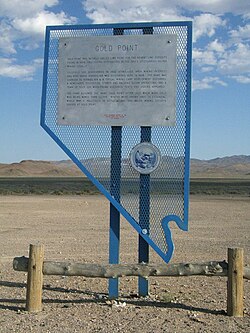Gold Point, Nevada
| Gold Point, Nevada | |
|---|---|
| Ghost town | |

Gold Point Historical Marker
|
|
| Location within the state of Nevada | |
| Coordinates: 37°21′17″N 117°21′54″W / 37.35472°N 117.36500°WCoordinates: 37°21′17″N 117°21′54″W / 37.35472°N 117.36500°W | |
| Country | United States |
| State | Nevada |
| County | Esmeralda |
| Time zone | Pacific (PST) (UTC-8) |
| • Summer (DST) | PDT (UTC-7) |
Gold Point, Nevada is a well preserved ghost town in Esmeralda County, Nevada.
The area that would become Gold Point was first settled by ranchers and a few miners during the 1880s. The small camp of Lime Point was formed a few hundred yards west of the present town, at an outcropping of limestone.
When new discoveries of gold and silver established the major mining towns of Tonopah and Goldfield, Nevada in the early 1900s, a flood of prospectors returned to Lime Point. In 1902 silver was discovered in the area, and the old camp was revived and renamed Hornsilver (an informal name for the silver mineral chlorargyrite). Scarcity of water in the area required that the ore be shipped to nearby Lida for milling. The nearest major supply town was about 250 miles north at Unionville, a mining town northeast of present-day Lovelock. The miners did not find silver in abundance, the costs of shipping the ore to Lida became too high, and, within a year, the settlement was abandoned.
In 1905, the Great Western Mine Company began operations about a half mile southeast of Hornsilver and discovered a rich silver vein which brought a stampede of miners back to the camp. In addition to the rich silver ore, gold was also mined in small quantities. By 1908, the tent homes turned into more permanent wooden structures and the camp became a town.
In May, 1908 the Hornsilver Herald began publication and the following week a post office was established. Before long the residents organized a chamber of commerce and numerous businesses sprouted up, including as many as 13 saloons. The chamber sought a railroad extension to Hornsilver, but this never happened. The nearest railroad depot was at Ralston, about 15 miles east of Hornsilver. As deep ore bodies were extensively developed, the town peaked at a population of around 1,000 with over 225 wood-framed buildings, tents and shacks throughout the camp.
The town’s original founders did not find the boomtown they had hoped for, as this strike also proved to be short-lived. In 1909, litigation due to claim jumping brought many of the area mining properties into the courts. These many lawsuits, along with inefficient and costly milling practices, halted the town’s growth just a little more than a year after it was established. Before long, most of its businesses closed and its residents again moved on.
But Hornsilver was not yet a ghost town, as mining operations resumed again in 1915. However, it must not have done very well as Charles Stoneham, of the New York Giants baseball team, purchased the Great Western mine in 1922 at a receiver’s sale.
...
Wikipedia


